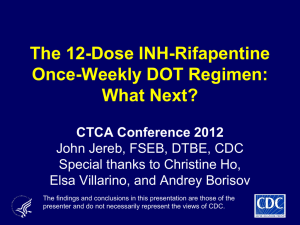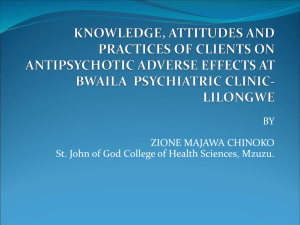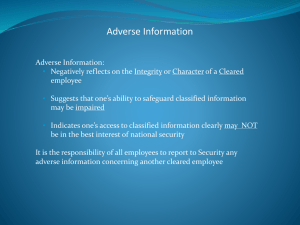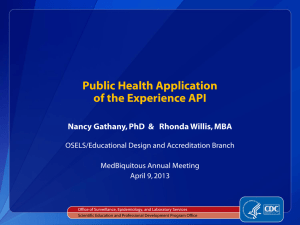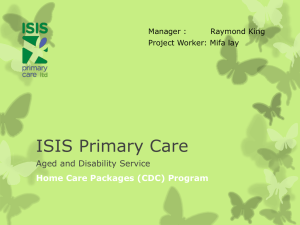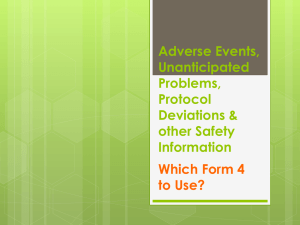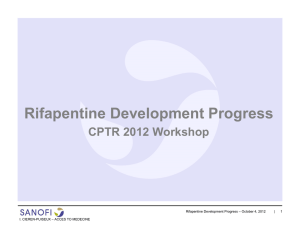The 12 dose INH-Rifapentine Once Weekly DOT Regimen
advertisement
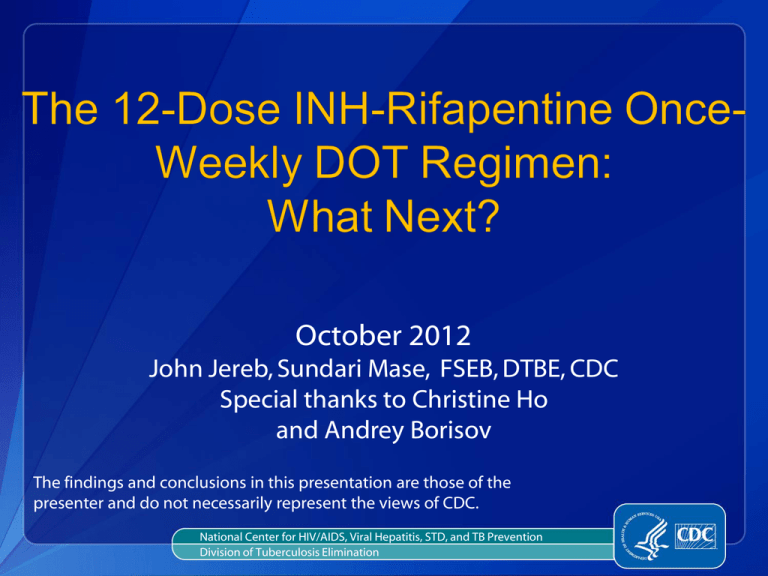
October 2012 John Jereb, Sundari Mase, FSEB, DTBE, CDC Special thanks to Christine Ho and Andrey Borisov The findings and conclusions in this presentation are those of the presenter and do not necessarily represent the views of CDC. National Center for HIV/AIDS, Viral Hepatitis, STD, and TB Prevention Division of Tuberculosis Elimination Disclosures • No financial conflicts of interest • Experimental treatment regimens • Off-label usage of FDA-approved medications Public Health Motivation • Treatment of latent M. tuberculosis infection is a key component of TB prevention and elimination. • 9 months of isoniazid (INH) is highly efficacious, but effectiveness is diminished by low completion rates (30–60%). • A shorter regimen is needed. – High completion rates, effectiveness, and tolerability Outline • • • • • Origins of current INH-RPT guidelines Summary of current guidelines Project for post-marketing surveillance Study 33: self-supervised INH-RPT Plans for additional guidelines Treatment Trial, Brazil • Schechter M. AJRCCM 2006 • Household contacts to AFB+ – 399 TST+ adults (age ≥ 18 yr) • 2 mo. daily RIF-PZA self-sup. – 20/193 grade 3 or 4 hepatitis – 1 TB case • 3 mo. DOT weekly INH-RTP – 2/206 grade 3 or 4 hepatitis – 3 TB cases Treatment Trial, RSA • Martinson NA. NEJM 2011 • 1148 HIV-infected, TST+; no HIV Tx – 6 mo. INH daily self-supervised – Indefinite INH daily self-supervised – 3 mo. INH-RIF twice weekly DOT – 3 mo. INH-RPT weekly DOT • Endpoint: TB-free survival • Followed up to 6 yr RSA Trial, Results • 58 TB cases overall • No TB difference by regimen • Death rate 5.7/100 P-Y 6 INH Indef. INH 3 INH-RIF 3 INH-RPT TB per 100 P-Y 3.6 2.7 2.9 3.1 AE per 100 P-Y 15.4 18.4 10.6 8.7 Treatment Trial, Brazil, Canada, Spain, and the United States • • • • • • Sterling TR. NEJM 2011 Largest trial (almost 8000 participants) Longest enrollment period Children age ≥2 yr Spectrum of “high-risk” predictors Both effectiveness and efficacy Difference in TB rates between the 2 study arms, and non-inferiority “delta” Modified Intention to Treat Population; A33 analysis Difference in TB rates between the 2 study arms, and non-inferiority “delta” Per Protocol Population; A33 analysis Reported Adverse Events Among persons receiving > 1 dose During treatment or within 60 days of the last dose Regardless of attribution to study drug 3HP N=4,040 325 (8.0%) P-value Grade 1-2 9H N=3,759 364 (9.7%) Grade 3 194 (5.2%) 181 (4.5%) 0.16 Grade 4 39 (1.0%) 34 (0.8%) 0.37 Toxicity 0.01 Reported Adverse Events Among persons receiving > 1 dose During treatment or within 60 days of the last dose Accounting for attribution to study drug Related to drug Rash only Possible HS 9H N=3,759 206 (5.5) 17 (0.5) 15 (0.4) 3HP N=4,040 328 (8.1) 35 (0.9) 158 (3.9) <0.0001 0.02 <0.0001 Other Not related 71 (2.0) 399 (10.3) 122 (3.0) 220 (5.5) 0.001 <0.0001 Toxicity HS: hypersensitivity reaction P-value Hepatotoxicity Among persons receiving > 1 dose During treatment or within 60 days of the last dose 9H N=3,759 113 (3.0) 3HP N=4,040 24 (0.6) <0.0001 Related to drug 103 (2.7) 18 (0.5) <0.0001 Not related 13 (0.4) 6 (0.2) 0.08 Toxicity All hepatotoxicity P-value MMWR 2011; 60: 1650–1653 CDC Guidelines for Weekly INH-RPT DOT, 12 Doses • Equal alternative for 9 mo INH – Otherwise healthy persons with LTBI and factors predicting progression – Age ≥12 yr • Consideration for other patients if feasibility favors INH-RPT • DOT MMWR 2011; 60: 1650–1653 INH and RPT Dosages CDC Guidelines for Weekly INH-RPT DOT, 12 Doses, Children 2–11 Years Old • Small numbers in treatment trials • No pediatric formulation of RPT • INH-RPT recommended if both – Notable risk of TB – Unlikely to complete 9 mo INH MMWR 2011; 60: 1650–1653 Not Recommended for • • • • Children <2 yr old Patients taking anti-retrovirals for HIV Women who are pregnant Patients with INH- or RIF-resistant LTBI Precautions • Exclude TB disease carefully if – “Class IV” (old, healed pulmonary TB) – HIV infection (i.e., not being treated) • Drug-drug interactions with rifamycins • DOT Completion of Therapy • • • • No evidence basis for definition criteria No consensus definition of completion No CDC guidance for interruptions PreventTB (Study 26) definition – 11 or 12 doses – Doses separated by >72 hr – Within 16 weeks Adverse Effects and Monitoring • Few problems in the treatment trials • Monitoring recommendations – Vigilance for hypersensivity • Thrombocytopenia • Hypotension – Hepatotoxicity • Baseline ALT for few conditions –HIV infection –Post-partum period –Liver disease; alcohol usage National Surveillance for Severe Adverse Effects • Since 2004, at DTBE • “Severe” = death, or hospital admission • LTBI treatment – Any regimen – At least one dose • Forms available by contacting LTBIdrugevents@cdc.gov • On-site CDC investigations, on request Adverse Effects in Study 26: Work in Progress • Hypersensitivity syndrome – Panel of immunologists – Working definition – One scientific abstract, submitted • Methadone interactions – Mainly, withdrawal – Preliminary findings in early 2013 Adverse Effects in Study 26: Work in Progress • Adverse effects trends analysis – Total AEs decreased over time – Most decrease: HS reactions – Findings in 2013 • Hepatitis sub-study – Matched case-control design – Focus on viral hepatitis infections – Findings in 2013 Adverse Effects in Study 26: Work in Progress • HIV extended enrollment • Pediatric extended enrollment • Focus on INH-RPT safety – 60 day monitoring is complete – Data collection is complete • 33-month monitoring is ongoing Post-implementation INH/Rifapentine Project Takin’ It To the Streets… (And Keeping it Safe) Sundari Mase, M.D., M.P.H. FSEB/DTBE/CDC LTBI Treatment and a History of Adverse Events “Those who do not remember the past are condemned to repeat it…..” – Santayana Learning from History This CDC-funded project will use the experience of the field to conduct postimplementation surveillance to inform national TB program activities • Actively monitor for adverse effects of the new 12 weekly dose INH-RPT regimen through TB programs • Collect information on programmatic issues • Treatment trials are not good predictors of program experience Objectives • Assess the use of INH-RPT in non-research settings for adverse effects – Collect ‘denominator data’ prospectively – Note if certain populations, risk factors or settings are more often associated with adverse effects • Assess adherence and treatment completion • Assess impact of INH-RPT on programs – Staffing – Costs • Match patients with TB registry at 2 years Program requirements • Use of INH-RPT regardless of project participation • Able to track and evaluate patients for adverse events • Able to notify CDC contact of adverse events within 1 day • Able to collect basic demographic information, number of people started and completed on regimen, and symptom review checklist from each weekly dosing visit INH-RPT Project Sites • • • • • • Arkansas Arizona – Pima Bureau of Prisons California Georgia Hawaii • • • • • • Illinois – Kane Kansas Mississippi Minnesota New Mexico Nevada • • • • • New York North Dakota Ohio – Columbus Oregon South Carolina • • • • Seattle WA Tennessee Virginia Wisconsin Information To Be Collected • Ideally would want the same information collected across sites and populations to promote comparability • Essential data- core set of variables needed for assessment – – – – Number of patients started and completed on regimen Weekly screening for symptoms and adverse effects Demographics in aggregate form Notification of adverse events • Full complement – ideal set of variables for assessment – – – – – Individual demographics Epidemiological risk factors (homeless, correctional) Medical risk factors (diabetes, HIV, smoking) Medications Timing of doses Program Evaluation • Effectiveness – Adherence – Medication procurement • Feasibility – DOT – Staffing – Cost Adverse Events • Key person for each project site and CDC contact person for adverse effects • All adverse events reviewed at DTBE • Conference calls (monthly) and transmission of information (quarterly) at set frequency – Ensure needed modifications are made – Share patterns of adverse events across sites • TB registry match at 2 years (or later) • Coalesce and report information Adverse Events • Approximately 650 patients started on INHRPT • Seven hospitalizations reported to CDC • Six out of seven have been investigated by CDC; the seventh investigation this week • Not all hospitalizations will be attributable to INH-RPT Take Home Messages • INH/Rifapentine has only been studied in treatment trials and the surveillance project tracks what is happening in the real world • CDC recommendation is to only give INH-RPT by DOT • Any SAE should be reported to Public Health • Important to track SAEs systematically, in real time Thank You! • Field Services and Evaluation Branch – – – – – – – – • Clinical Research Branch – – – – • Terry Chorba John Jereb Sundari Mase Mark Lobato Neha Shah Field Medical Officer Team Evaluation Team Program Consultants and Public Health Advisors Andy Vernon Elsa Villarino Andre Borisoff Stefan Goldberg Surveillance, Epidemiology and Outbreak Branch – – Tom Navin Krista Powell TBTC Study 33: iAdhere • Comparison of DOT, SAT INH-RPT, and Short Messaging Service (SMS) • Open label • Randomized by household group • Primary endpoint: Tx completion • MEMS caps monitoring for SAT • 1000 patients, age >18 yr TBTC Study 33: iAdhere • Opened for enrollment September 18 • 2 of 13 sites • Phased in, site by site FDA Review for LTBI Indication • Meeting with Sanofi Aventis, September 4 • Study 26 data from CDC • No foreseeable timetable Guidelines: What’s Coming • • • • • New Targeted Testing Guidelines ATS, IDSA, CDC collaboration AAP participation Evidenced-based structure Forecast: summer 2013
